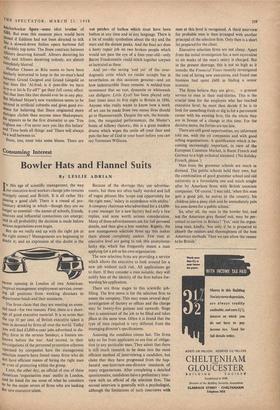Theatre
The Indestructible Monument
By ALAN
BRIEN
Little Eyolf. By Henrik Ibsen.
(Lyric, Hammersmith.) `Jump out of a train anywhere between Wimbledon and Hasle- mere; walk into the first villa you come to; and there you are'—so wrote George Bernard Shaw demonstrating to the ostrich-heads the real, con- temporary, suburban accuracy of Ibsen's Little Eyolf. Sixty inglorious theatrical years later the task is not so easy. If you hopped off today you might find the Huggetts tangled in incest, or the Archers fiddling their income-tax, or the Dales covering up a faulty and fatal diagnosis by the Doctor. But you could not possibly find anyone resembling the Allmers family as they appear at the Lyric, Hammersmith. The fault lies first in David William's direction, second in Michael Meyer's new translation, and third in the writing of the old whiskered Scandinavian sapper himself, Henrik Ibsen.
The two central characters are not a month out of date—in fact their twentieth-century counter- parts arrived in the West End only this year. Alfred Allmers is George Dillon with snow on his boots :.a sensitive with all the stigmata of literary genius who is haunted by the fear that he hasn't enough talent to write the book-notes on a pro- vincial weekly newspaper. When we meet him for the first time, he has just packed in his monu- mental work on Human Responsibility and decided to take life easy on his wife's moneybags. Rita Allmers is the Cat on the Icy Tin Roof : one of those Scandinavian stalactites'who are chilly on the eye but fiery to the touch. When we meet her for the first time, she has determined to keep her thin-blooded husband tied to the bedposts until she gets her money's-worth. Caught in the rugged in-fighting between these two failed idealists is Little Eyolf, their crippled son. As a basic plot, this is more powerful and direct than George Dillon, more balanced and therefore more gripping than Cat on a Hot Tin Roof. And in all three plays the unbearable revelations come in the middle act where two human beings strip each other not only of masks, clothes, and pretensions, but also of the very skin off their backs.
Unfortunately, at Hammersmith the decor, the costumes and the performances are designed with a sort of perverse ingenuity to look as much like parody Ibsen as possible. The first set has the over- bright, over-arranged staginess, with the sunlight pouring in from two opposite angles at once, of an exhibit at the Ideal Home Exhibition. Set number two is from a touring pantomime of Babes in the Wood, with gloomily unlikely trees painted on gauze. And the third set is a jetty which slopes like Mont Blanc and makes the dizzy actors cling to the papier mache like ants to a boulder.
That subtle and careful actor Robert Eddison as Alfred becomes a weak baby face hidden be- hind ginger whiskers and topping a starved knick Gas.
Passe d like a Wo Allure wife, coMpl He ettnila betwet that 10.0_0 Not th tut sPraye dence dialog He ap frighte and be a :rbocker figure—some idiot brother of But even this museum piece would have I if Eddison had not been directed to talk slowed-down Italian opera baritone full bbly top notes. The Ibsen contrasts between rs deceiving himself, Allmers deceiving his and Allmers deceiving nobody, are almost etely blurred.
other Chasen as Rita seems to have been rly instructed to keep in the no-man's-land Grand Guignol and Grand Gingold so Ines like 'Al-fred, is it poss-ible we have -st litt-le Ey-olf?' get their full comic effect. tat lines like that should ever be in any play. Michael Meyer's new translation seems to be d in artificial cobwebs and gives good evi- for believing that Ibsen originated more ue clichés than anyone since Shakespeare. pears to be the first dramatist to use 'You en me—I've never seen you like this before' Time heals all things' and 'There will always all between us.'
n, too, must take some blame. There are wet patches of bathos which must have been bathos at any time and in any language. There is a lot of muddy symbolism about the sky and the stars and the distant peaks. And the final act does a hasty repair job on two broken people which would not pass the eye of a four-year-old—only Baron Frankenstein could stitch together corpses as lacerated as these.
And yet—the saving 'and yet' of the over- dogmatic critic which no reader accepts but is nevertheless on this occasion genuine—and yet how indestructible Ibsen remains. A welded 'iron monument that no rust, dynamite or whitewash can disfigure. Little Eyolf has been played only four times since its first night in Britain in 1896. Anyone who really wants to know how a work of art can be made from two messy lives should go to Hammersmith. Despite the sets, the transla- tion, the misguided performances, the Master's bouts of billowy rhetoric, this is a great modern drama which wipes the smile off your face and puts the fear of God in your heart before you can say Tennessee Williams.



































 Previous page
Previous page